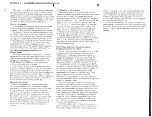
Composing with tELHARMONIC: (Cont’d)
CHORD PROGrESSIons:
With Interval set to TRIAD, DEGREE is the easiest parameter to sequence for traditional diatonic chord
progressions in which the sonority of the chord changes according to its scale position. Because of this, the
tELHARMONIC is quite a bit more versatile than past synth engines with “Chord modes”. Clever sequencing
of DEGREE, together with TONIC and INTERVAL (especially if limiting the CV depth on INTERVAL so that it
only reaches the three Triad inversions) gives access to a great variety of possible chord progressions and
key modulations.
In the past, the use of “chord machines” has typically involved selecting a chord structure such as “major” or
“minor” and then moving the whole structure up and down when sequencing. Such blatantly-parallel
movement would be anathema to the contrapuntal chorale writers of yore, but the sound of this type of
chord progression is integral to many classics in the history of electronic music. To emulate this and
sequence so-called “techno chords”, simply pick a chord structure using INTERVAL and DEGREE and then
sequence only TONIC while leaving DEGREE static
Composition Tips and Tricks:
TrIAD MoDEs:
Set Interval to Triads (anywhere below 11:00). Use the Degree panel control to choose a mode. For Ionian
(Major) and Aeolian (minor), use the RGB LED to find the starting point. Aeolian is a Blue or Periwinkle Triad
that will be found one “click” to the left of the Orange Triad. Ionian is a Green/Aqua Triad that will be found
one “click” to the right of the Orange Triad. Now, patch a sequence from BRAINS, René or Wogglebug to
Degree to sequence chords in your chosen mode.
Starting from the Green Triad (one click to the right of Orange), here are the seven available modes:
Ionian (Green)
Dorian (Blue)
Phrygian (Blue)
Lydian (Green)
Mixolydian (Green)
Aeolian (Blue)
Locrian (Orange)
SEqUencIN g wITH AccIDEnTals:
Choose a mode as described in “Triad Modes”. Sequence a chord progression of your choice. Use the
unquantized CV output of René, or another row of Pressure Points Tuned Voltages, to modulate Interval to
Unison or Octaves on steps where you would like accidentals to be possible. For these steps, adjust the
sequence values for Degree so that the desired accidental is produced.
VIBRATO vIA FM IN :
In addition to the timbral sculpting possible with this input (detailed in the “Sculpting Timbre with
tELHARMONIC” section) the FM IN is also a fantastic way to introduce vibrato, pitch bend to a melody
or progression. Patch any fast control voltage or expression voltage to the FM IN to experiment with
this technique. Even a Gate signal could be attenuated and applied to this input to achieve
sequenced pitch bends.
VaRI aTIons on a MUsIcal MOTIF:
Set DEGREE and TONIC Panel controls of the tELHARMONIC to the lowest desired pitch. Patch a sequence
from René CV OUT to Signal IN on a VCA such as the modDemix. Patch a Tuned Voltage OUT from Pressure
Points to the CARRIER/ CV IN on the modDmix. Set Carrier/ CV Strength attenuator to Full CW. Patch the
Signal OUT from the associated modDemix channel to the DEGREE CV IN on tELHARMONIC. Set DEGREE CV
Attenuator to Full CW. Now, each Pressure Points Stage can be set produce a variation on the Musical Motif.
Summary of Contents for Soundhack tELHARMONIC
Page 1: ...v 2 2...




























